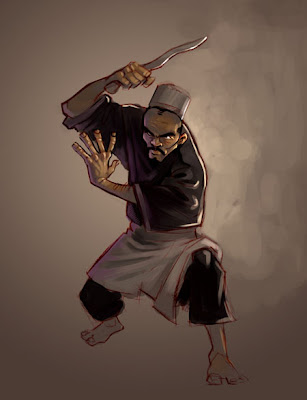31 December 2007
Goodbye 2007...
30 December 2007
What is authenticity in Silat?

29 December 2007
Kuntau in the Malaysian mind

28 December 2007
Tari Gayong Otar-Otar
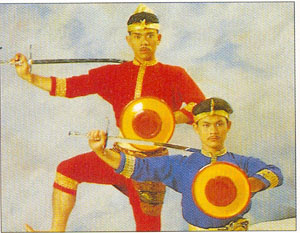
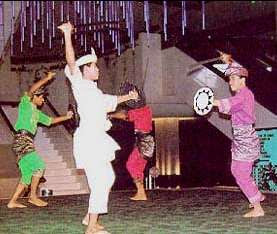 A row of dancers moves forward offensively while the other row moves backwards defensively in tune to the sounds of gongs and drums. For every movement, the rows remain intact.
A row of dancers moves forward offensively while the other row moves backwards defensively in tune to the sounds of gongs and drums. For every movement, the rows remain intact.
27 December 2007
Tribute to a hidden diamond
Menghantar lancar sebagai tawaran,
Untung rugi sedada labur,
Bergelek sisi secarik kapan.
Lancarnya qiam peluru bermata,
Rukuk merendah kepada Ilahi,
Dipanjat doa diwakil segala.
Supaya Selawat Selamat Sampaikan,
Gawang Gayang Gerak Gagalkan,
Gantung Gayung Gagah Guntingkan.
26/12/2007
Petaling Jaya

26 December 2007
Invitation: International University Pencak Silat Championship 2008
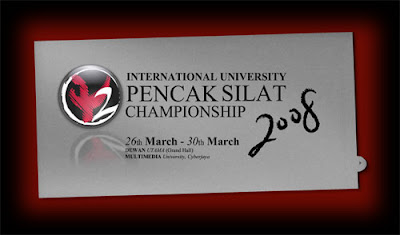 This invitation is extended to undergraduates in universities all over the world! You are invited to take up the challenge in the International University Pencak Silat Championship 2008
This invitation is extended to undergraduates in universities all over the world! You are invited to take up the challenge in the International University Pencak Silat Championship 2008Date
26-30 March 2008 (4 days)
Venue
Main Hall, Multimedia University Cyberjaya, Malaysia
Organisers
1.Persatuan Silat Seni Gayung Multimedia Universiti (PSSGM MMU)
2. Kementerian Belia dan Sukan (KBS)
3. Kementerian Pengajian Tinggi Malaysia (KPT)
4. Persekutuan Pencak Silat Kebangsaan (PESAKA)
5. Telekom Malaysia Berhad (TM)
Brief
The International University Pencak Silat Championship 2008 (KPS 08) is a follow-up of the Multimedia University Pencak Silat Tournament 2007. This time around, Persatuan Silat Seni Gayung Multimedia Universiti (PSSGM MMU) has been given the proud honour of hosting this prestigious event.
The championship seeks to discover new talent in the Silat Olahraga and Silat Seni arena, which will give birht to new champions at the SEA Games, Commonwealth Games and other levels.
As many as 24 golds, 24 silvers and 42 bronze medals are u for grabs in 24 contested categories.
We expect 30 contingents from 16 countries to participate. Thus far, 18 teams including 4 international teams and 14 domestic teams have confirmed their participation.
The confirmed international teams are Azerbaijan, India, Indonesia and Singapura.
Application forms and the terms and conditions are posted at http://pssgm.mmu.edu.my/kps08.
Contact
For more information, please contact:
Noordiana binti Ahmad
Assistant Director II, International University Pencak Silat Championship 2008
Email: ms.noordiana@yahoo.com
Tel: +6012-4346003
Sourced from: Universiti Silat Antarabangsa
25 December 2007
Contributions needed for surgery
He needs RM2000 to complete the operation as soon as possible and aid, however little, will contribute greatly to covering the cost.
For more details on the operation and costs involved, you may contact me at webmaster[at]silatmelayu.com.
Thank you to my beloved brother and friend of Silat Kuntau Tekpi USA who committed to covering part of the cost immediately after I informed him of the situation. Your sacrifice is an inspiration to me.
24 December 2007
silatmelayu.cjb.net
So, if you can't remember whether there's a hyphen or not in my blog's address, just type in http://silatmelayu.cjb.net/ and it will bring you straight here.
Thanks for not laughing.
23 December 2007
Silat: The Definition - A Prologue
To Madmike, thank you for the question. I sat down to write the answer, but after several different drafts, I discovered that I had hit a wall. I knew for a fact what silat is. I eat, breathe and sleep silat. But the problem is, how do we nail down something that is so fluid, so dynamic?
If you were to ask me what Silat Cekak is, or what Silat Sendeng is, I could give you a fair answer. But, if you asked me, what silat is... don't get me wrong. I do have an answer. The question is, do you have the time?
On the verge, of giving up, I suddenly realised, that this is exactly what SilatMelayu.Com and Silat Melayu The Blog is about, getting the message across.
Therefore, the next few posts will be dedicated to trying to create a comprehensive thesis of silat, crystalising its spiritual, philosophical, communal and practical basis as well as trying to define the major characteristics and components of silat.
For those masters and instructors around the world reading this, and saying either out loud or in their hearts, "Good luck with that!", I thank you.
I'll certainly need it.
22 December 2007
Senaman Tua: An Excerpt
 The following is an excerpt from the bilingual Senaman Tua Melayu book recently published by AGM Sdn Bhd and written by guru Azlan Ghanie, founder of Silat Melayu Keris Lok 9 and Senaman Tua (ST). This, then would be considered the official view of its founder.
The following is an excerpt from the bilingual Senaman Tua Melayu book recently published by AGM Sdn Bhd and written by guru Azlan Ghanie, founder of Silat Melayu Keris Lok 9 and Senaman Tua (ST). This, then would be considered the official view of its founder.Introduction
Senaman Tua ("petua" the advice of the elders/tip, while "Tua" means old) is founded by guru Azlan Ghanie. The word 'Senaman' is interpreted as a physical movement or exercise whereas 'Tua' is translated as ancient since it is inherited from the people of the past.
Senaman Tua was inspired by the teachings of guru Azlan's father, Abdul Ghanie bin Abu Bakar, who originated from the royal Melayu family of Merpati Jepang from Sarawak. His family is also connected to the silat family of his mother's Bugis ancestors (Rogayah binti Jaafar, Jaafar bin Endut).
Incidentally, Endut was the person who unified all Pahang silat gurus from Pahang and had also revived silat at Gong Kapas in Kuala Terengganu, Terengganu, during the 1930s and 1940s. His son, Jaafar, taught silat to the royal Melayu family in Kampung Gajah, Perak and Johor in the 1940s.
History
The exercises begin with the raising of one's spiritual and physical well being. This is why Senaman Tua begins with an upright standing posture and a smile before practising proper breathing (using the Nafas Melayu technique), and the physical exercises begin from the soles of the feet.
The concept of 'beginning from your feet' in Senaman Tua comes from the advice of his mother's friends who often stoppd by his home in Pekan, Pahang. According to Melayu culture, one has to pour cold water on one's feet first before proceeding to bathe the other parts of the body. With that, the first Senaman Tua exercise begins with the soles of your feet.
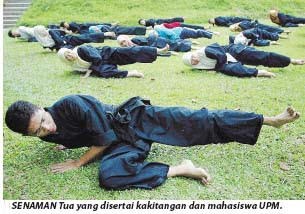 Joints and Senaman Tua Basics
Joints and Senaman Tua BasicsSenaman Tua originates from the basics of standing, in particular, how the Melayu stand, sit, lies down and move. All of these movements tell a story like that of a complete and well-dressed warrior.
In the sitting exercise, they start with the cross-legged sitting position on the floor. from this position, one can extrapolate various different leg exercises such as folding, tiptoeing, squatting, stretching, etc.
In the concept of self-defense, sitting cross-legged will also train preparedness in defending against attacks from the 4 compass directions (front, rear, left, and right) with minimum movement.
The sitting exercise is followed by prone exercises (lying on your back).
After the prone session, Senaman Tua enthusiasts can do the hand exercises while standing. Focus is given to the joints and the strength comes from practising the 'petua'.
To the warrior, the palms are regarded as the 'fruit' or the 'furthest fruit'. The elbow is the 'inner fruit' and when the hand is straightened it is regarded as the 'branch'. The shoulder is the base of the branch.
This Melayu exercise system specialises in building speed and strength. More precisely, the exercises focus on joint strength via its various extrapolations.
One of the hand exercises strengthens the shoulders and, among is foundation for locking and takedown techniques in Silat Melayu by pushing the enemy's shoulders to the ground and livens up the body's movement in self-defense acts. It also heals injury in the shoulders, nape and waist if done correctly under the guru's supervision.
One of the hand dances can develop into strikes, traps, locks, counterlocks and other techniques. The knowledgeable martial artist will be able to unlock various locks with a minimum effort or strength.
Senaman Tua has an objective and to pursue this journey, it begins from an origin. Breathing too has an origin, i.e. concentration is focused in the navel. The same thing applies in performing Senaman eTua exercises when sitting, lying down, hand dances, standing and striding; there is a clear objective when it starts from the base.
In these gentle Melayu exercises, besides those done upon waking from sleep and the imitation of animal body movements, exercises like bathing, washingclothes by the river, boat rowing and various other movements have been adopted. the 'stretching out' movement culminates in the waist area whether the torso is raised or remains upright (focusses on the navel and waist).
In sports science this technique is called stretching and is also known in Senaman Tua as 'body relaxation', where one has to stretch out to acquire this stimulating feeling.
The ancient Melayu believed that the body will not be at ease either due to an improper diet or because of lack of exercise. It is believed that the body contains 'wind'. In sports, if you cannot perform well, it is said you are 'winded'. When you go for a massage you will definitely burp (so will the masseur) when you are releasing 'wind'.
The moves in Senaman Tua come from Silat Melayu where it was practiced in the ancient palace households. It was used in countering attacks from their enemies. In their fights, speed, strength and accuracy were their priorities (they still are). Quick thinking, speed in dodging, strength in attacking and accuracy to the targeted points on the enemy's body had been and still are the major requirements.
When seeking combative knowledge, the warrior's highest priority is delving into his inner self. Such knowledge imparts thus: To be missed when stabbed at and to counter when evading. It means that, when facing his enemy, he is ready to evade, deceive and attack - all simultaneously. When attacked, he evades and deceives, and he attacks without the enemy being able to counter.
Silat is also acknowledged as a study in movements which deliver attacks and counter-attacks with speed, strength and accuracy. The breathing technique of Nafas Melayu enlivens or brings alive the movements in Silat, further enhancing these unique movements.
Nafas Melayu becomes the starting from which all movements are born. This method is thought to have been acquired from the reflex actions of frightened children. It is well known in the Melayu community as 'contraction of the stomach', where frightened children ran so fast that they literally jumped over wide ditches and climbed tall trees.

This method produces unique strength. In combat, the enemy attacks from different angles and one has to evade and step out of attacks or step in to deliver attacks. It becomes the basis of speed and liquid movement. After the Nafas Melayu routine, the body is ready to move like the wind.
The sole exercise is the beginning of the physical exercise to complete the body's movement in combat or Silat with the soles coming coming alive to step, to wiggle the waist, dodge or evade and to deceive with the flower hand dance.
That's the philosophy of Melayu self-defense in Silat. As proclaimed - where there's spirit, there's soul. The spirit means living, whereas the soul is the strength in the moves. Each exercise in Senaman Tua has its own story. The story is to stride or retreat and therefore your ankle joints need to be strong. The ankles are the key instrument in carrying the body's weight.
You can build such strength to carry the body by practicing the tiptoe exercise. Concentration then is on the knee joints because the knees need to bear the body's weight and to maintain balance. Concentration is then centred towards the waist before proceeding to the hand exercises such as the wrists, elbows and shoulders.
The Melayu warriors do not increase their muscles in size for strength. Strength is obtained from strengthening of the joints in exercise.

21 December 2007
Senaman Tua
In the past 10 years, a system of exercise known as Pilates has taken the United States by storm. An interesting fact about Pilates is that it was developed as a way of rehabilitating injured soldiers. It is touted as a low-impact strengthening programme, that will give you functional strength instead of the bulky musculature that comes from lifting weights.
In the three years that I have been practicing and teaching Silat Kuntau Tekpi, I find Senaman Tua to be a challenging, necessary, and overly rewarding aspect of training. In my opinion, western students of Silat Melayu, have great difficulty being on the receiving end of buah kuncian.
I have always told my students that Senaman Tua is like a ‘yoga’ to preserve and strengthen the joints. After three years, I have at least 50% greater range of motion in my wrists, shoulders and elbows. I have also been able to rehabilitate an old knee injury almost completely.
So, if we are seeing such dramatic results in cases where the person already has an injury, how much more important is this as a protective measure for those who are not injured? Another interesting example is a student of mine who competes in long-distance marathons. He is fit, limber, eats right, and is generally the very picture of good health. Last year I took him through a Senaman Tua session for about 45 minutes.
Following is an excerpt from one of my first conversations with Brother Nadzrin, after I had asked him to elaborate on the meaning of the terms:
SENAMAN TUA literally means Old Exercise but to do it justice, I prefer to translate it as Sagely Exercise. The word TUA in Malay commonly means old in English. However, the difference between our cultures mis-communicates the term.
TUA comes from the Archaic Melayu/ Sanskrit word TUHA which means Prime. From this word comes TUHAN (God), TUA (Old), colours like BIRU TUA (Dark Blue), KETUA
(Leader), PENGETUA (Principal) and many others.
However, another interpretation of SENAMAN TUA as explained by its founder guru Azlan Ghanie is that it is a shortening of PETUA which comes from the Arabic word Fatwa. A fatwa is a conclusive decision or result of detailed research and development by a master in a particular field. For example, e=mc2 is a fatwa of Einstein who reduced the relationship of energy and matter into five symbols.
Therefore, the SENAMAN TUA is bound by a minimum of four PETUA, Nafas Melayu, Lam Alif, Mata Angin and Jantan Betina. There are more but are merely extrapolations.
20 December 2007
Universiti Silat Antarabangsa
 Universiti Silat Antarabangsa is born! This brand-spanking new blog is run by a well-respected silat teacher, Ustaz Imran Azmi who is also the current Secretary of the Malaysian Grand Maasters Association (MAGMA), a writer for SENI BELADIRI magazine and a prolific silat researcher.
Universiti Silat Antarabangsa is born! This brand-spanking new blog is run by a well-respected silat teacher, Ustaz Imran Azmi who is also the current Secretary of the Malaysian Grand Maasters Association (MAGMA), a writer for SENI BELADIRI magazine and a prolific silat researcher.The blog will approach silat from an research-based and academic angle and define for all, just what silat actually is. The posts so far look promising and I invite all Silat Melayu: The Blog readers to bookmark this site.
For our international readers, have no fear. I am trying to get permission to translate selected articles into English for our blog here. That way, I don't have to think so much about what to write :)
Go to http://universitisilat.blogspot.com/ to visit.
19 December 2007
Logging off... for now

To all my Muslim readers, I wish you Eid Mubarak and to those currently in Makkah to do their Hajj, may Allah accept your sacrifice and efforts and may you attain Hajj Mabrur. Amin.
I have several articles on the backburner to be posted after my return and I hope to complete them by then.
Keep your comments and emails coming and thank you for reading and supporting Silat Melayu: The Blog.
P.S: I'm sure you've noticed that we have a new advertising bar above the masthead. Please visit our sponsors to support us by clicking on the above advert. Thank you.
18 December 2007
How to stand a keris

.jpg) There are two ways to stand a keris. One is on its handle, and another is on its tip. Believe it or not, it is easier to stand a keris on its tip than it is on its handle. So, today, we'll choose the easier one to do.
There are two ways to stand a keris. One is on its handle, and another is on its tip. Believe it or not, it is easier to stand a keris on its tip than it is on its handle. So, today, we'll choose the easier one to do.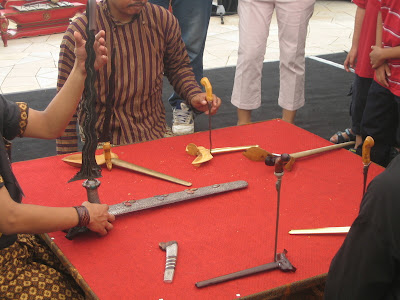

17 December 2007
Pukulan 7 Hari Workshop

16 December 2007
Silat need to take a hard look at their performance
15 December 2007
Hang Tuah E-comics

14 December 2007
13 December 2007
The results are in...
PETALING JAYA: Malaysia's campaign in silat ended without a gold after world champion Rina Jordana Adnan was beaten in the Under-50kg final at the Sungnoen Municipality Hall in Korat on Wednesday.
The sole Malaysian in the fight for a gold medal in 12 silat olahraga finals contested on the final day of competition, was beaten 1-4 by Indonesian Pengky Simbar.
Malaysia, who brought 14 exponents to Korat targeting four gold medals, finished with a haul of one silver and six bronzes, their worst ever result in the biennial Games since the sport was introduced in 1987.
The only other time when they failed to win a gold medal was in the 1997 Jakarta Games, hauling back only five silver and seven bronze medals.
The bronze medallists in Korat were Faizal Abdullah, Ahmad Shahril Zailuddin, Wan Nurul Hidayu, Malini Mohd, Emy Lajip and Mastura Sapuan.
At the last Games in Manila, Malaysia took back three gold medals in silat.
Exponents return with their worst ever result
MALAYSIA's campaign in silat ended without a gold with the defeat of world champion Rina Jordana Adnan in the Under-50kg final at the Sungnoen Municipality Hall in Korat yesterday.
The sole Malaysian in the fight for the gold medal in 12 silat olahraga finals contested on the final day of competition was beaten 1-4 by Indonesian Pengky Simbar.
Malaysia, who brought 14 exponents to Korat with the target to win four gold medals, thus finished with a haul of one silver and six bronze medals, their worst ever result in the biennial Games since the sport was introduced in 1987.
The only other time when they failed to win a gold medal was in the 1997 Jakarta Games. Then, they had five silver and seven bronze medals.
The bronze medallists in Korat were Faizal Abdullah, Ahmad Shahril Zailuddin, Wan Nurul Hidayu, Malini Mohd, Emy Lajip and Mastura Sapuan.
At the last Games in Manila, silat contributed three gold medals.
It was certainly a big blow for Malaysia who had won seven gold medals at the World Championships in Kuantan in October.
All the seven gold medallists in Kuantan - Ahmad Shahril, Mohd Azrin Abdul Malek, Norhasmizan Abdullah, Malini, Rina, Mastura and silat seni exponent Suzy Mohd Sulaiman - competed in the Korat.
12 December 2007
Can you identify these weapons?

The picture above depicts two weapons that belonged to my late maternal grandfather, whose family descended from the Yemeni bloodlines of the Achehnese teukus. We still don't know how they came into his posession or if they had anything to do with his lineage.
These weapons are safely kept in my uncle's home in Singapore. He says the blades were given to my grandfather as a gift. I've never known him to be a martial artist, so it could be true. What bothers me is that, these blades are actually proper weapons, not tourist-made items.
The Parang
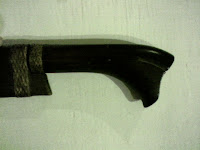 The parang-like weapon, although light and thin, is perfectly balanced. I initially thought it was a cousin of the Parang Ilang of Borneo because of the sheath and the simpai (rattan binding), but it has been hinted to have a Sumateran origin. The hulu allows for a comfortable forward and reverse grip and mimics the shape of a Lading. It is however, very light and the blade is thin and razor sharp.
The parang-like weapon, although light and thin, is perfectly balanced. I initially thought it was a cousin of the Parang Ilang of Borneo because of the sheath and the simpai (rattan binding), but it has been hinted to have a Sumateran origin. The hulu allows for a comfortable forward and reverse grip and mimics the shape of a Lading. It is however, very light and the blade is thin and razor sharp.From the time I first posted this article on this blog, two readers have given me feedback on the origins of both weapons.
 Ustazshifu says, "I got one similar to the long 'lading' like parang, I'm sure it is the same type. Yes, it is light and strong. The blade will always stay sharp, razor sharp. My mom called it 'Parang Bangkong'.
Ustazshifu says, "I got one similar to the long 'lading' like parang, I'm sure it is the same type. Yes, it is light and strong. The blade will always stay sharp, razor sharp. My mom called it 'Parang Bangkong'."But one of my students, which are very experienced in traditional weapon and silat, said that it is from 'lading' family. He been persuading me to sell or give it to him. :-)"
In my subsequent conversations with him, he reconfirmed that the make is the same. Thus, the type could very well be a Parang Bangkong and related to the Lading.
The knife
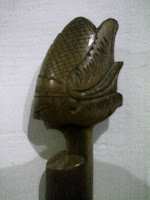 The other weapon has a straight blade and comes with a wooden sheath that locks into place without any mechanism. When sheathed, the blade is perfectly hidden and the hulu is carved with a simple face, but not deep enough to compromise its utility.
The other weapon has a straight blade and comes with a wooden sheath that locks into place without any mechanism. When sheathed, the blade is perfectly hidden and the hulu is carved with a simple face, but not deep enough to compromise its utility.The tang of the blade is snugly buried into the wooden hulu, which makes it sit comfortably in the hand while the ring finger wraps around the neck of the figure. It, too is razor sharp.
Another reader, Poknik, was kind enough to identify this weapon. He said, "I know I've seen it before...somewhere in Kelantan. (I think it's classified under straight short badik (without 'lok' of course) The cool part is that it's a bit tricky in terms of presentation. First impression if seen worn - nobody will think that it's some kind of dagger/weapon due to its design. Reminds me of - kinda like that one 'tongkat' design (with blade almost hidden)"
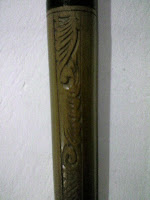 "Funny that you mention the word "Acheh". FYI, you may or may not know, that many of the Kelantanese silat styles & weapons are said to have come from Acheh, Minang, Java etc. (surprised?) How this influence started on a very far land? (Yes there are some Thai influences as well but not that much) Well, it's a long story -something to do with 'ancient royalty' ... Thus, my guess could be right that I could have seen similar weapon in Kelantan (which I'm not surprised if it is of Acheh origin)".
"Funny that you mention the word "Acheh". FYI, you may or may not know, that many of the Kelantanese silat styles & weapons are said to have come from Acheh, Minang, Java etc. (surprised?) How this influence started on a very far land? (Yes there are some Thai influences as well but not that much) Well, it's a long story -something to do with 'ancient royalty' ... Thus, my guess could be right that I could have seen similar weapon in Kelantan (which I'm not surprised if it is of Acheh origin)".It looks like a trip to Kelantan is in order.
To all blog readers, if you have any more information on the exact types and history of these blades, please post your email in the comments section and I will contact you. Alternatively, you may email me at silatmelayu[at]gmail.com.
Your information would allow me to further deepen my research into their origins and actually find out how they came into my grandfather's possession.
Thank you.

11 December 2007
Wali Jantan: The Hidden Weapon of Silat Cekak Hanafi
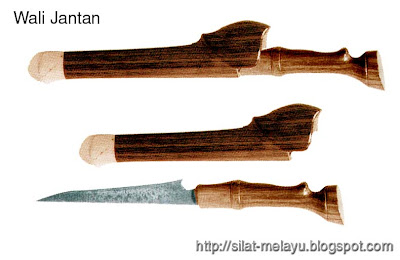
The Wali is a traditional wood carving knife used by Melayu woodcarvers in Peninsular Malaysia. It is a favourite amongst carvers because it produces finer shapes than a chisel does. This is the primary difference between Malaysian carvings and those from Indonesia or Thailand which employ the chisel to remove wood chips.
The Wali is also used as a stripping knife to create long bamboo strips for weaving or even as a fillet-like tool to strip fat and meat from cattle skin which will be used to make the Wayang Kulit shadow puppets.
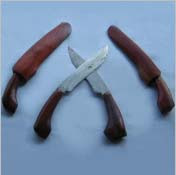
Pisau wali buat peraut,
Camca jatuh patah berdengung,
Gila latah ikan di laut,
Melihat umpan di kaki gugung.
Stripping with the Pisau Wali,
A falling spoon hums as it breaks,
Excited are the fish in the sea,
To see the bait at the water’s edge.
Wali Jantan
The Wali Jantan is a single bladed knife-like weapon that acts as a companion to the Lading, Silat Cekak's official weapon. It shares only its name with the Wali but is obviously of a different design. When drawn from the sheath and held in a forward grip, the sharpened edge actually points upwards, thus negating its use as a slashing instrument. It becomes immediately clear that this weapon was designed to stab.
According to a statement made by guru utama Md Radzi Haji Hanafi of Silat Cekak Hanafi, the name Wali means Ahli, which could be translated as Expert or Specialist. Jantan means Manliness.
The weapon, which can be held in both forward and reverse grip, is used by selected members of Silat Cekak Hanafi. It is conferred by the guru utama to anyone he wishes. Currently, it has been reported that only 10 people have been awarded a Wali Jantan.
Proof of existence?
The uniqueness of this weapon, like the Lading Cekak, which doesn't exist in the arsenal of any other silat lineage makes its origins and history difficult to trace. The Wali Jantan was introduced publicly by guru utama Md Radzi in 2000. Because of this, it is hard to corroborate the claim that it was used by the Panglimas of Kedah in the last century. The weapon was previously kept secret.
However, I have personally seen a Wali Jantan owned by Haji Amruddin Buang, a senior Cekak master who claimed to have received it from Allahyarham Ustaz Hanafi himself.

Aside from this, the website Memori Kedah (http://memori-kedah.net/) records photographs of a Wali Jantan in its museum with a similar design. It states that the hilt is made from buffalo horn and the cap at the end of the sheath is made of ivory. There are carvings on the sheath and the cap. The length of the blade from hilt to tip is approximatel 26.5cm and the length of the sheath is approximately 21cm.
Measurements
The measurements of the Wali Jantan are kept secret by the guru utama. Those who receive the weapon will be taught how to use it. It is said to be an effective weapon when fighting in pitch darkness. It is used for both attack and countering.
When attacking, the user employs a unique method that allows them to unsheath the blade with one hand in a split second. The handle and sheath design also facilitate this function. As part of its smithing custom, the process has to begin and end on the same day of the week.
Wali Betina
In his book Silat Melayu: The Malay Art of Attack and Defence, Ku Ahmad Ku Mustaffa mentions that the Wali comes in two varieties, the Wali Jantan and the Wali Betina. However, he makes no distinction between nor description of them and only relates how the Wali is similar to a golok and is used in the fields.

The Memori Kedah website also documents the existence of the Wali Betina and states that both hilt and sheath are made of wood while the cap on the end of the sheath is either made of horn or ivory. The blade's length from hilt to tip is approximately 26cm and the length of the sheath is approximately 23cm.

10 December 2007
Silat Seni Gayong Training in the 1970s
Silat Seni Gayong in Malaysia owes a huge debt to its founder, Allahyarham Datuk Meor Abdul Rahman Uda Hashim for creating such a buzz in the Melayu mind.
He singlehandedly revived interest in Silat at a time when Silat only meant a traditional dance. There was even a time when the word Silat was synonymous with Datuk Meor and Gayong.
The following video is a tribute to him and his students, for carrying Gayong to such a pinnacle.
Semoga Allah merahmati rohnya dan roh murid-muridnya yang sudah pergi meninggalkan kita
09 December 2007
Open Invitation to Majlis Perhimpunan Hari Haul Silat Kuntau Tekpi 2007
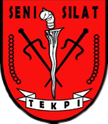
Secretary
Pertubuhan Seni Silat Kuntau Tekpi Malaysia
Kuala Lumpur Chapter
08 December 2007
The Lading Cekak

The Lading is a unique single bladed weapon that has served Melayu as both a tool of war and farming. The weapon, which is normally classified as a type of Parang (machete-like blade) is made up of three distinct parts: the Hilt (hulu), the Blade (bilah) and the Sheath (sarung).
The word Lading exists in many several Nusantara languages, including Banjar and Kutai, which use the term to mean knife. During the 1948-1960 Emergency Period in Malaya, the Banjar united the Melayu in Sungai Manik, Perak to oppose the Communist Threat. This was conducted as guerilla warfare and named the Perang Sabil (Religious War) or Perang Sungai Manik and employed among other weapons, one similar to a sword called the Lading.In language
In the Minang culture, the Lading is clearly a parang, as mentioned in this poetic verse:
Si-Muncak mati tarambau,
Kaladang mambao ladieng,
Adaik jo syarak di Minangkabau,
Ibaraik aua dengan tabieng.
Si Muncak dies in a fall,
To the field we bring a parang,
Custom and religion in Minangkabau,
Is as the bamboo and the riverbank
And the Melayu sayings:
Belakang lading kalau diasah lama-lama tajam juga
Translation: Sharpen the back of a lading and eventually it will be.
Meaning: A fool, when taught well, will eventually become wise.
Mencencangkan sesuatu lading yang hilang/ lading patah
Translation: Slashing with a lost lading/ broken lading.
Meaning: Taking pride in something worthless.
Lading tajam sebelah.
Translation: A lading with only one sharpened edge.
Meaning: A taker, but never a giver.
Bagai lading tak tahu akan majalnya.
Translation: A lading unaware of its own bluntness.
Meaning: Someone who never realises his sorry state.
Memakuk dengan belakang lading
Translation: Chopping with the back of a lading
Meaning: Making a request or an inquiry that offends another person.
Although it rightly started out as a farmtool, but the utility of the weapon has made it a favourite among several groups of users. There is a difference of opinion as to its origins. Some scholars point to the long age of the Kedah kingdom and theorise that being the dominant culture, it would have influenced the exportation of the lading to Sumatera.
Others theorise that large kingdoms often attract immigration and influx of knowledge and technology from outlying areas, suggesting the lading being imported from Sumatera instead. Either way, it was well-known that Kedah once had very strong political and trade links with Acheh and undoubtedly this is when the use flourished.
As with many Nusantara weapons, the exact design date of the Lading cannot be ascertained. It is clear, however, that the basic design of the Lading follows the theme of the traditional round-tipped parang.
The Lading can generally be categorised into two types, based on location, Sumateran and Malaysian from which two sub-categories can be observed: Lading Kedah and Lading Cekak. These categorisations are mine, to lend easier understanding.
Lading Kedah
The Lading Kedah is often forged without a sheath, unlike its Sumateran cousin. The Lading Kedah is often used as a farmtool and has no unique specifications between different forging.
It is customary to fashion the hulu (hilt) from the horn of the Balau buffalo. There are etchings on the tip of the hulu ring-shaped etchings on the top area of the hulu. Some assume that the etchings help to keep a grip on the tool.
Although within the state, farmers are normally seen carrying the lading over their shoulder with the blade facing outwards, outside of Kedah, the Lading is not as well known as the ever-regal Keris. It is often confused for its cousin, the Kelewang, which is widely used in Kedah and Kelantan because of its higher utility. The Kelewang is often designed with hooks and tentacles for odd jobs and farmwork, whereas the Lading more often has only a hacking and slashing function.
A normal measure for the Lading Kedah is:
- Blade body= 60cm.
- Tang breadth = 1.5cm
- Blade body width = 0.5cm
- Blade breadth at tip = 7cm
Lading Cekak
 The present Lading Cekak is a recent innovation, believed to be introduced by Allahyarham Ustaz Hanafi during the height of Silat Cekak's founding in the 1960s as a continuation of an older warrior tradition. The Lading Cekak has 3 unique attributes:
The present Lading Cekak is a recent innovation, believed to be introduced by Allahyarham Ustaz Hanafi during the height of Silat Cekak's founding in the 1960s as a continuation of an older warrior tradition. The Lading Cekak has 3 unique attributes:- The measurement
- The grip, and
- The cutting edge
Like many Nusantara weapons such as the Keris and the Pedang, the Lading also employs the customisation philosophy by ensuring that each weapon is tailor-made according to specific measurements off the user's body. Each measurement has a corresponding philosophical meaning.
These measurements have been published as:

- Blade body (A): Equivalent to the distance between the left ear to the right eye, or the right ear to the left eye, which means: "Whatever seen or heard, the blade will find".
- Tang width (B):Equivalent to the width of the thumbnail.
- Blade tip width (C): Equivalent to the length of the thumbnail.
- Cutting edge length (D): Equivalent to the distance between the two eyes.
- Hilt (E): Shaped like a deer's hoof.
Rumours suggest that there are other measurements, but that these are supposedly kept secret to preserve the copyright of the weapon.
GripThe Silat Cekak practitioner always only uses a reverse grip to keep the weapon hidden behind the forearm in a standing position. The hulu employs the Melayu handle shape (curved) which allows the user to hold the weapon comfortably in his hand.
Any weapon, when held in a reverse grip, will naturally yaw away from the forearm. This forces the wrist to bend downwards to keep it against the forearm. To compensate for this, the hulu is curved away from the hand, while the body of the blade bends towards the upper arm, sometimes in sharp angles, thus reducing the radical weight to nearly zero. This bend is named the Lentik Pelepah Kelapa (Coconut Leaf Bend). Other non-Cekak ladings also use Lentik Pelepah Pisang (Banana Leaf Bend).
The sharp-ended hulu can also be used to strike the ribs, solar plexus or the face.
Cutting edge
The cutting edge of the Lading doesn't extend along the whole body of the blade. The only sharpened edge sits at the final few centimetres at the blade's tip. This innovation allows the Lading to not only act as a cutting instrument but a leveraging one.
The blunt edge of the Lading can be used to parry incoming arm or leg attacks by meeting the opponent's forearm, upper arm or lower leg. As the blunt metal makes contact, follow through movements apply greater pressure to the parried appendage and slides across it, until the blade comes to the sharpened edge.
What follows is a deepening incision that cuts straight to the bone and exits just as cleanly, by seesawing the hulu. Because of the apparent weaponlessness of the practitioner, opponents are often caught unawares by the solid parry which cuts at the last moment.
Targets for the Lading are often the abdominals, triceps, jugular, ribs and the inner thighs.
Method
The Lading is used in Silat Cekak as an add-on to their empty hand methods. Thus, since Silat Cekak employs a 99% defensive and 1% attacking policy, the Lading is never used to initiate a strike, rather to counter it.
Material
The body of the weapon is made of metals culled from specific backgrounds of former use, similar to the Keris's '7 Pa' of nominal metals: paku, parang, payung, puting, pahat, pedang, pemukul. These secret metals are forged together with other materials to add bisa (poison) to the blade.
The Hulu is made from the horn of a male Balau water buffalo (Kerbau) or a female water buffalo. It is claimed that powder scraped from the hulu can be applied to a Lading wound as first aid to staunch bleeding.
Lading players in history
According to Silat Cekak lore, the famous Panglima (War generals) of Kedah wielded these Ladings into battle. The most well-known among them are Panglima Ismail and Panglima Tok Rashid.
This claim is corroborated by Pak Guru Sani Zainol Abidin of Silat Kuntau Tekpi, who is the direct descendant of Panglima Taib, of the Baling district in Kedah. He says that the Lading is a favoured weapon among the Panglima of the period between 1804 and 1879.
How to get one? The Lading is granted by the Guru Utama (Principal) only to those who have contributed much within Cekak (currently represented by two organisations, Persatuan Seni Silat Cekak Malaysia and Persatuan Seni Silat Cekak Ustaz Hanafi Malaysia).
The Lading is granted by the Guru Utama (Principal) only to those who have contributed much within Cekak (currently represented by two organisations, Persatuan Seni Silat Cekak Malaysia and Persatuan Seni Silat Cekak Ustaz Hanafi Malaysia).
This tradition is said to have been carried over from Kedah, when the Lading Berambu was given to honoured Panglima by the Sultan.
Similar Lading uses
Aside from Silat Cekak, the Lading also exists as an optional weapon for Silat Kalimah, which according to Pak Guru Zuhdi Mat Yusof (guru utama of Persatuan Seni Silat Kalimah Yahya Said), is used in alternating reverse and forward grips, unheard of in Cekak.

The Lading belonging to Panglima Tok Rashid, a common ancestor in both Silat Cekak and Silat Kalimah lineages is now kept in the safekeeping of the leadership of Silat Kalimah.
The Lading is also part of the arsenal of Silat Kuntau Tekpi which, other than its normalised weapon, the Tekpi, also teaches various common and uncommon traditional weapons such as the Keris, Rantai (chain), Cindai, Tongkat and many more.
Mahaguru of Silat Harimau Bentara Garang, Pak Jaafar also reports that the Lading can be used as a stabbing weapon, using the sharp triangle tip to penetrate straight to the heart.
 All pictures are copyright of their respective owners.
All pictures are copyright of their respective owners.
07 December 2007
Silat: Parts 1 and 2
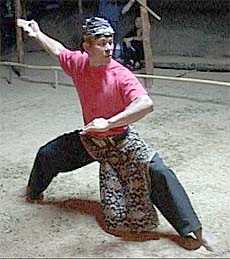
aesthetically returning
to the Source
with great harmony
of the seen and unseen
within
I stop my planning obsession
and let the
Great Plan plan for me
I move with beauty
where evil has long gone
in the seen and unseen
very much quickly
than the others
my art in flesh
Naying Lucifer
Ayeing Parakletos
God...Down I swim in your sunless sea
The beauty beyond fantasy
The way of life this is
The Secret Touch
has turn me into lightning
03 December 2007
Senjata Makan Tuan?
I had studied Silat Cekak Hanafi before Sendeng, and was taught that the parang Lading, the official weapon was smithed according to specific measurements of the owner, thus making it a perfect combat companion. Any error on the smith's part could cause the weapon to 'makan tuan' or accidentally hurt its owner.
I had also studied Silat Melayu Keris Lok 9, which taught that a personal Keris needed to be 'serasi' (affinitive) to the owner, and similar physical measurements were required to avoid the weapon 'betraying' him.
Guro Omar Hakim also gave measurement rationale for Pekiti Tirsia Kali for the length of certain sticks and knives used, which determined the proper grip required.
My question to Haji Jamaludin was based on all of this experience. So, I asked the question of the sword in Sendeng:

02 December 2007
SEA Games Korat 2007: Email from O'ong Maryono
 The SEA Games 2007 is currently being held in Thailand and the Pencak Silat events will be contested from the 7th to 12th December 2007. To make all participants more comfortable, O'ong Maryono, representing the Pencak Silat Association of Thailand (PSAT) recently sent out a welcoming email.
The SEA Games 2007 is currently being held in Thailand and the Pencak Silat events will be contested from the 7th to 12th December 2007. To make all participants more comfortable, O'ong Maryono, representing the Pencak Silat Association of Thailand (PSAT) recently sent out a welcoming email.Dear friends,
O’ong Maryono
01 December 2007
Lian Padukan Outtakes from Human Weapon - Silat
Here are some outtakes from the Lian Padukan shoot of Human Weapon: Silat, The Martial Art of Malaysia. The producers didn't allow any footage to be published before the episode aired. There were some pretty embarassing moments that never made it to the final cut, including the real reason Jason and Bill wore chest protectors.
They also have photos of the shoot. Look out for the one where the crew try to break 'buah keras' with their bare hands. Click on the link below to view their gallery.

